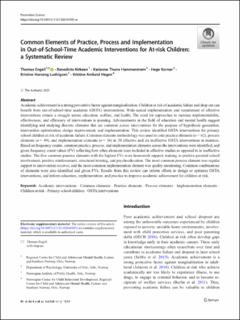| dc.description.abstract | Academic achievement is a strong preventive factor against marginalization. Children at risk of academic failure and drop out can benefit from out-of-school-time academic (OSTA) interventions. Wide-scaled implementation and sustainment of effective interventions remain a struggle across education, welfare, and health. The need for approaches to increase implementability, effectiveness, and efficiency of interventions is pressing. Advancements in the field of education and mental health suggest identifying and studying discrete elements that are common across interventions for the purpose of hypothesis generation, intervention optimization, design improvement, and implementation. This review identified OSTA interventions for primary school children at risk of academic failure. Common elements methodology was used to code practice elements (n = 62), process elements (n = 49), and implementation elements (n = 36) in 30 effective and six ineffective OSTA interventions in matrices. Based on frequency counts, common practice, process, and implementation elements across the interventions were identified, and given frequency count values (FV) reflecting how often elements were included in effective studies as opposed to in ineffective studies. The five common practice elements with the highest FVs were homework support, training in positive parental school involvement, positive reinforcement, structured tutoring, and psychoeducation. The most common process element was regular support to intervention receiver, and the most common implementation element was quality monitoring. Common combinations of elements were also identified and given FVs. Results from this review can inform efforts to design or optimize OSTA interventions, and inform education, implementation, and practice to improve academic achievement for children at risk. | |
